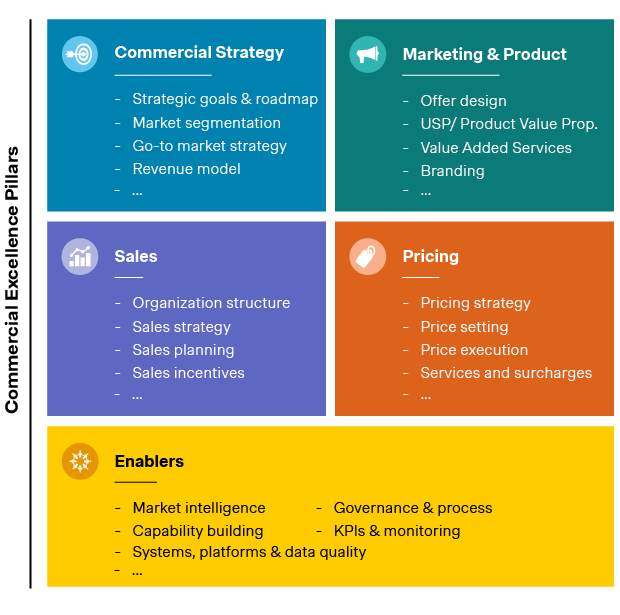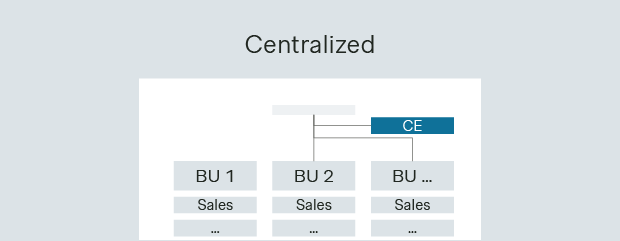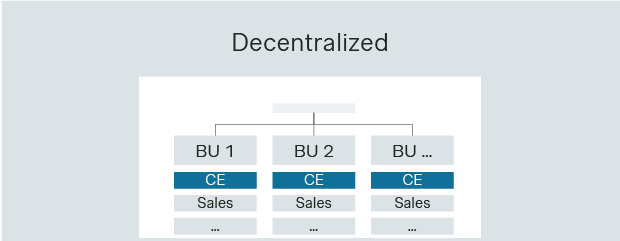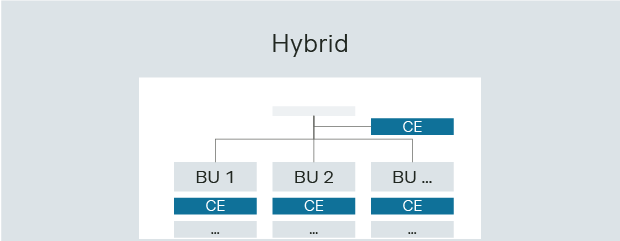B2B organizations often oscillate between centralizing commercial functions for efficiency and decentralizing for local responsiveness, yet neither approach consistently delivers lasting impact. A well-designed Center of Commercial Excellence (CoCE) offers a strategic alternative: aligning vision, capabilities, and governance to enable scalable, profitable revenue growth and streamlined execution across markets.
Many B2B companies find themselves trapped in an endless cycle: centralizing their commercial functions to gain scale, then pulling resources back to empower local teams, only to repeat the process when performance falters. This tug-of-war not only limits strategic clarity but also creates overlapping accountabilities that distract from serving customers.
A Center of Commercial Excellence (CoCE), when properly defined and sponsored, transforms this tumult into a cohesive strategy. By uniting expertise, tools, and processes, it sharpens the organization’s commercial focus and delivers measurable impact on profitability and growth. In the sections that follow, we outline a step-by-step framework for establishing a CoCE designed to catalyze sustainable commercial growth.
Setting the foundation: vision and executive sponsorship
Before designing any new organizational structure, it is essential to articulate a clear vision and mission. What strategic and commercial goals will the CoCE support? What is its purpose? How will it support the organization and how will it deliver value? Answering these questions builds a compelling case for executive leadership.
Securing visible sponsorship from the C-suite and buy-in from key stakeholders in the organization ensures the CoCE gains the authority, resources, and cross-functional collaboration it needs to succeed.
Designing your target operating model
With executive backing secured, the next step is crafting a fit-for-purpose target operating model. Cookie-cutter templates often miss the mark because they overlook unique organizational challenges and culture. Instead, tailor the CoCE’s structure (reporting lines, decision rights, and support services) to your company’s size, sector focus, and maturity.
A thoughtfully designed model eliminates overlap with local teams, clarifies handoffs, and fosters accountability, all while allowing enough flexibility to address market-specific nuances.
Bundling the right capabilities
A successful CoCE brings together the core commercial capabilities your business most urgently needs. Start by cataloguing existing activities such as pricing analysis, proposal development, sales training, and performance reporting by using the Commercial Excellence framework as guidance. Identify gaps or new tasks, assign ownership between CoCE and regional teams, and define where capabilities will be developed.

Image: Commercial excellence framework.
Structuring for collaboration and governance
Once capabilities are mapped, it is time to outline the CoCE’s structure within the broader organization. Should a centralized CoCE support all business units, or do differences across BUs warrant a more decentralized model? Alternatively, would a hybrid model balance strategic alignment with local flexibility? Each model has trade-offs, and selecting the right setup requires evaluating benchmarks, best practices, organizational fit, and alignment with the overall vision.
By defining responsibilities and a clear governance structure upfront, the organization avoids confusion and ensures every commercial function has a clear home.
Organization design | Center of Commercial Excellence setup can take different forms depending on the organization’s nature and prevailing business context as seen in the following structure examples:

In a centralized model, the Centralized Commercial Excellence (CE) team serves all divisions. This model:
|
|
|

In a decentralized model, the Commercial Excellence teams are embedded within each division. This drives:
|
|

A hybrid model combines the Centralized Commercial Excellence team plus dedicated resources within divisions. The Central Commercial Excellence team sets strategy and local Commercial Excellence teams execute and provide feedback. This enables:
|
|
Resourcing for impact
The CoCE will only be able to drive meaningful impact if it is equipped with sufficient resources - both in terms of talent and funding - to execute its mandate effectively. Assessing current performance in commercial activities and benchmarking against industry best practices helps estimate the CoCE’s staffing needs. Determine the number and mix of full-time equivalents required to deliver commercial excellence at scale.
Launching with clarity and momentum
To ensure focused efforts - especially during the potentially resource-constrained early phase of the CoCE - it is critical to identify the organization's overarching commercial must-win battles, prioritize and sequence initiatives, and strike a balance between quick wins and long-term objectives. This should culminate in a commercial implementation roadmap that acts as a guide, playbook, and performance yardstick for the CoCE.
Bringing the organization along on the journey is essential - plan your communication strategy carefully. Prepare clear, concise materials that articulate the CoCE’s mission, operating principles, and expected benefits. Organize town halls and regional briefings to address questions, build excitement, and signal strong leadership commitment.
From design and delivery of solutions to tracking value
Designing the CoCE is only the beginning. The true impact comes from bringing it to life - developing tailored commercial solutions and actively supporting the business. To kick off this phase, it’s critical to establish a transformation office or PMO to coordinate solution design, rigorously track execution of commercial must-win battles, and monitor value creation.
Building the right cross-functional team is challenging, and executing multiple initiatives in parallel demands strong coordination, disciplined KPI tracking, and the agility to adjust course as needed. This marks the beginning of a journey toward commercial excellence - one that, if well-executed, can deliver significant margin uplift and lasting organizational value. Careful planning and disciplined execution are essential to ensure its success.
How Simon-Kucher can help
At Simon-Kucher, we specialize in commercial excellence and helping organizations realize sustainable growth. Our industrials sector experts have guided businesses across Asia Pacific and around the world in creating high-impact Centers of Commercial Excellence. Ready to get started?
Contact us today to explore how a tailored CoCE can deliver long-term benefits and position your company for lasting success.


